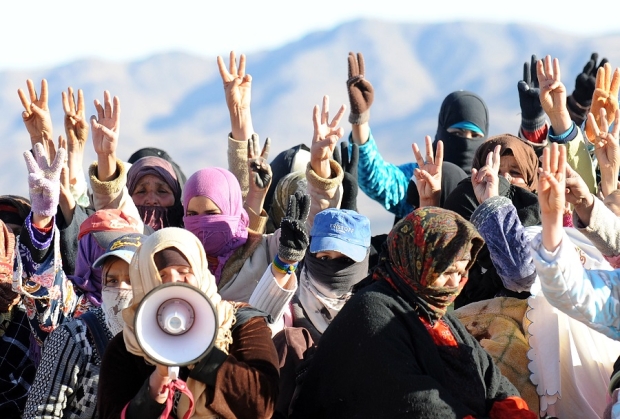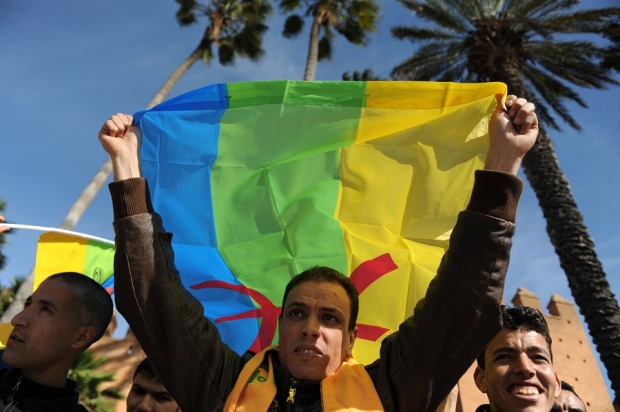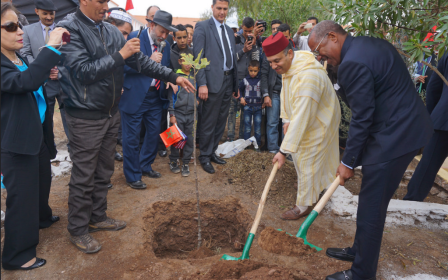Morocco's Amazigh women fight for language rights and place in society

KHEMISSET, Morocco - “All the governments since independence have shared the vision that Morocco is an Arabophone country, where there are only Arabs, and only one religion, Islam. This meant we had to learn a language that didn’t belong to us,” says Amina Zioual, the president of the Voice of Amazigh Women, a Moroccan campaign group.
Zioual’s work takes her to some of the farthest reaches of Morocco; high in the Atlas and Rif Mountains of the centre and north. She is promoting the lives and experiences of the rural Amazigh women, otherwise known as Berbers - a term considered offensive by most Amazigh, the original inhabitants of North Africa. These women live in small communities in some of the country’s harshest mountain valleys, where it is blazing hot in summer and often blanketed in snow in winter.
An estimated 27 percent of Morocco’s population speaks one of three dialects of the Amazigh languageTamazight (Ta’rift, Tamazight and Tashilhet) as their mother tongue, a language which has links with other Berber dialects across North Africa and the Sahel and is written in the unique Tifinagh alphabet - but until very recently it has had no official recognition. Almost all schooling in Morocco has historically been in Moroccan Arabic (Darija) or French, as has all official administrative and government business.
Imbalance between Arabic and Tamazight
In a small village, in a parched valley outside the Middle Atlas town of Khemisset, being excluded as a Tamazight speaker has had a powerful effect on the life of Maimouna Hassan, a 57-year-old woman who has lived in a two-room, barely furnished concrete building perched on the hillside since she got married. “I don’t speak Arabic. If I knew how to speak Arabic I would go and live in the city and do something with my life, but I can’t so that’s why I’ve stayed here. I don’t even know what the Quran says because I can’t read Arabic.”
Activists like Zioual are fighting to put an end to these women’s marginalisation. “Those of us who grew up speaking Tamazight knew that unless we left behind our mother tongue and learnt a language which was so-called ‘better’ than ours, Arabic, we would never be able to move into the higher positions in society.”
The historical imbalance between Arabic and Tamazight goes back deep into Morocco’s history. It is thought that the early Amazigh were Christians and pagans, but many converted to Islam from the 7th century onwards as Arab Muslims arrived in North Africa from the Middle East. What followed was more than a thousand years of intermarriage and mixing between the groups, with Moroccan Arabic becoming heavily influenced by the Amazigh language.
The suppression of Tamazight
Although it is impossible today to talk about the idea of separate races, during the French colonial protectorate in the early 20th century some divisions between the groups resurfaced. Several Amazigh families held important positions and some Amazigh children were offered a French education.
However, at Morocco’s independence, it was Arab nationalists who gained the upper hand, and the Arab-speaking sultan from the Alaouite dynasty, Mohammed V, became Morocco’s first king in 1956.
His religious authority drawn from his claimed descent from the Prophet Mohammed helped to unite a newly independent Morocco, and Arabic, the language of Islam, became predominant. During the rule of Morocco’s second king, Hassan II, a number of rebellions against the state broke out in the Amazigh’s High Atlas heartlands. This led to the use of Tamazight in public being suppressed, and parents were not allowed to choose Amazigh first names for their children.
Tamazight, an official state language - someday
Despite this difficult period at early independence, the balance shifted dramatically in 2011 when Morocco underwent its own Arab Spring protests, known as the February 20th movement. Under pressure from street demonstrations, King Mohammed VI helped to push through a new constitution which, amongst other things, for the first time promised to make Tamazight an official state language. The proposed law has been largely welcomed by campaign groups, but they remain disappointed that progress has been slow.
“It was a great first step, in fact it had to be because Amazigh people are fed up of waiting,” says Hha Ouadadess, a prominent member of the Amazigh community and a former professor of mathematics based in Rabat. “But it was supposed to be complete within five years and that deadline has passed. It’s time for the law to be implemented.”
According to the constitution, the current parliament had one term to enact an "organic" or constitutional law setting out how Tamazight should be made official. Although a draft law has been drawn up by the government, time is running out to get it approved by the Ministerial Council, presided over by the king, before Morocco’s national legislative elections due on 7 October.
MEE did reach out to Morocco’s Minister of Communications Mustapha el-Khalfi for comment but did not hear back from him in time for this report's publication. However he had made clear in June 2016 that the law will be passed before the end of the current parliament’s mandate. “The law is ready and will be heard before the Government council as soon as possible.”
Even if it is possible to get the law passed before 7 October, some activists would actually prefer a further delay in order to ensure the law is as good as it can be. They complain that consultation with civil society has been lacking, and in the current draft version details of exactly how Tamazight is to be made official are scant.
“We want to know how long it’s going to take to train up teachers to teach in Tamazigh. We want to know what proportion of the national media is to be dedicated to Tamazight-language programming. Otherwise it’s just vague and it will be impossible to implement,” says Meryem Demnati, deputy secretary general of the Observatory of Amazigh Rights and Liberties.
The Amazigh’s place in modern society
It's not only about language. There are also wider questions about the Amazigh’s place in modern society. Although most of Morocco’s population is culturally mixed, those small villages in the Rif and High Atlas regions are where most mother-tongue Tamazight speakers live. These are places where roads, clinics and schools are still few and far between. Although there has been much progress in the last 20 years in connecting these villages, bringing electricity and services and improving roads, there are still many rural Amazigh women who never learnt to read and write.
Morocco’s rural female illiteracy rate is 41.9 percent. As Maimouna Hassan's experience attests, this has had an impact on the ability of many Amazigh women to find jobs and integrate into wider Moroccan society. “Our marginalisation and economic position is linked to our Amazigh identity,” says Amina Zioual. “If our women had been given a proper education in their mother tongue, they would be able to find work and improve their healthcare and that of their children.”
As Morocco gears up for its important legislative elections, where the ruling moderate Islamist party the Justice and Development Party (PJD) is expected to face a stiff challenge from the secular Authenticity and Modernity Party (PAM), it seems unlikely that there is now sufficient time and political will to push through this constitutional law, along with a number of others promised in 2011, before 7 October.
Nevertheless, it is vital to appreciate how far Morocco has come, and with some schooling now beginning in Tamazight and the draft law waiting to be passed, it is hoped that it is just a matter of time before the language gains its rightful place alongside Arabic as an official language.
New MEE newsletter: Jerusalem Dispatch
Sign up to get the latest insights and analysis on Israel-Palestine, alongside Turkey Unpacked and other MEE newsletters
Middle East Eye delivers independent and unrivalled coverage and analysis of the Middle East, North Africa and beyond. To learn more about republishing this content and the associated fees, please fill out this form. More about MEE can be found here.








